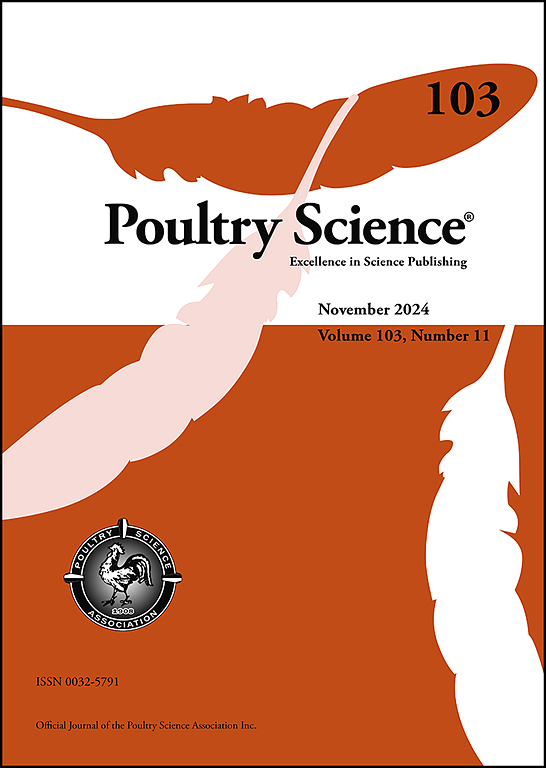腺苷脱氨酶促进鹅星状病毒基因型II在GEF细胞中的复制
IF 3.8
1区 农林科学
Q1 AGRICULTURE, DAIRY & ANIMAL SCIENCE
引用次数: 0
摘要
鹅星状病毒基因型II (GAstV-II)是鹅内脏和关节痛风的病原体,自2016年以来在中国广泛传播,给水禽产业造成了相当大的经济损失。腺苷脱氨酶(ADA)是一种参与嘌呤代谢和尿生成的重要酶,据报道其在胃粘膜腺病毒感染中表达上调。然而,关于ADA在病毒复制过程中发挥的调节作用的知识仍然有限。本研究首次从鹅胚成纤维细胞(GEF)中克隆出鹅ADA (gADA),系统发育分析表明其与鸭ADA高度同源,核苷酸序列同源性达96.6%。此外,GAstV-II感染促进了gADA的产生,但未改变其在细胞质和细胞核中均匀分布的细胞分布模式。进一步的结果表明,gADA的异位表达显著提高了GEF细胞中病毒衣壳蛋白的表达和病毒载量。相反,siRNA敲低gADA在病毒复制中发挥相反的作用。值得注意的是,gADA可以直接与病毒衣壳蛋白相互作用,特别是与它的c端结构域相互作用。我们的数据阐明了gADA在GAstV-II感染中的调节作用,为进一步探索其发病机制奠定了坚实的基础。本文章由计算机程序翻译,如有差异,请以英文原文为准。
Adenosine deaminase promotes goose astrovirus genotype II replication in GEF cells
Goose astrovirus genotype II (GAstV-II), the causative agent of visceral and joint gout in goslings, has been widespread in China since 2016 and resulted in considerable economic losses to waterfowl industry. As an important enzyme involved in purine metabolism and uricogenesis, adenosine deaminase (ADA) is reported to be upregulated via GAstV infection. However, knowledge about the regulatory role of ADA played during virus replication is still limited. In the present work, goose ADA (gADA) was firstly cloned from goose embryo fibroblasts (GEF) and phylogenetic analysis showed that it was highly homologous with duck ADA, sharing 96.6 % identity in nucleotide sequences. Moreover, GAstV-II infection promoted the production of gADA but did not change its cellular distribution pattern, which was evenly dispersed in the cytoplasm and nucleus. Further results demonstrated that ectopic expression of gADA significantly enhanced viral capsid protein expression and virus loads in GEF cells. Conversely, knockdown of gADA by siRNA played the opposite role in virus replication. Notably, gADA could directly interact with viral capsid protein, particularly with its C-terminal domain. Our data elucidated the regulatory role of gADA during GAstV-II infection, thereby laying a solid foundation to further explore its pathogenesis.
求助全文
通过发布文献求助,成功后即可免费获取论文全文。
去求助
来源期刊

Poultry Science
农林科学-奶制品与动物科学
CiteScore
7.60
自引率
15.90%
发文量
0
审稿时长
94 days
期刊介绍:
First self-published in 1921, Poultry Science is an internationally renowned monthly journal, known as the authoritative source for a broad range of poultry information and high-caliber research. The journal plays a pivotal role in the dissemination of preeminent poultry-related knowledge across all disciplines. As of January 2020, Poultry Science will become an Open Access journal with no subscription charges, meaning authors who publish here can make their research immediately, permanently, and freely accessible worldwide while retaining copyright to their work. Papers submitted for publication after October 1, 2019 will be published as Open Access papers.
An international journal, Poultry Science publishes original papers, research notes, symposium papers, and reviews of basic science as applied to poultry. This authoritative source of poultry information is consistently ranked by ISI Impact Factor as one of the top 10 agriculture, dairy and animal science journals to deliver high-caliber research. Currently it is the highest-ranked (by Impact Factor and Eigenfactor) journal dedicated to publishing poultry research. Subject areas include breeding, genetics, education, production, management, environment, health, behavior, welfare, immunology, molecular biology, metabolism, nutrition, physiology, reproduction, processing, and products.
 求助内容:
求助内容: 应助结果提醒方式:
应助结果提醒方式:


